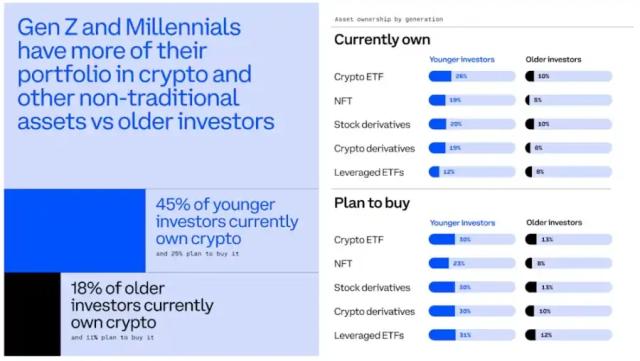Authors: Dan Morehead, Paul Veradittakit, Franklin Bi, Jeff Lewis, Erik Lowe, Mason Nystrom
TechFlow by: TechFlow
This article is Pantera Capital's outlook on the development of crypto in 2025. This is a collection of four articles, analyzing future trends from multiple dimensions, including blockchain moving towards mainstream adoption, three key trends in 2025, crypto will help the dollar's dominance, and RWAs will promote the integration of DeFi protocols.
TechFlow TechFlow compiled the full text and the following is the content of the article.
Blockchain’s 100x Opportunity: The Path to Mainstream Adoption
Author: Franklin Bi, General Partner
How can cryptocurrency truly go mainstream?
When we look past the noise and speculation, this is the only question worth focusing on. As investors, it is our job to find the path to widespread adoption of cryptocurrencies, because that is where the next 100x growth opportunity lies.
However, top venture capitalists are not prophets. They focus on the present and see reality with great clarity . One thing is certain: 2025 will be a turning point for the crypto industry.
Imagine what the Internet would look like if Jeff Bezos was sentenced for selling books online? What if Steve Jobs was sanctioned for launching the App Store? Or Jensen Huang had to build Nvidia abroad because his bank account was frozen? This is exactly the dilemma the blockchain industry has faced in the past few years.
However, 2025 will mark a major milestone in blockchain’s history — the first time entrepreneurs, regulators, and policymakers will have the opportunity to clear the barriers that have prevented mainstream adoption.
Facing this increasingly clear path, we need to rethink: What opportunities will appear on the future adoption path? Which areas may breed investment opportunities that are 100-fold or even 1,000-fold?
Just as “SoLoMo” unlocked the potential of the internet in the 2010s, the convergence of three major trends will drive blockchain mass adoption starting in 2025:
Gateway : Connecting traditional financial systems to blockchain;
Developers : Lower the development threshold, allowing more people to easily build blockchain-based applications;
Application : Create blockchain applications that are truly integrated into daily life and have practical significance.
Gateway: The bridge between traditional finance and blockchain
Looking back at the history of Wall Street, from the introduction of electronic trading in the 1970s to the digitization of payments today, this 50-year technological upgrade tells us an important fact: all financial assets will eventually flow to those places where they can achieve the freest flow, most efficient transactions and create the greatest value.
Currently, blockchain networks carry $3 trillion worth of crypto assets (such as Bitcoin and Ethereum), as well as a portion of asset-based tokens (such as tokenized US dollars and treasury bonds). However, globally, the total amount of financial assets held by households, governments, and companies exceeds $1 trillion. This means that blockchain still has 300 times the growth potential in the field of financial assets.
So where are we now? It can be said that the game has not even started yet and the players are still warming up. The global balance sheet has just begun to migrate to the blockchain. To achieve this goal, we need powerful gateways to connect the traditional financial system with the blockchain world.
We need to expand platforms that can efficiently introduce new users and existing assets. For example, Bitso in Latin America has used blockchain technology to process more than 10% of US-Mexico remittances. And tokenization platforms like Ondo are competing with financial giants such as Franklin Templeton and BlackRock, planning to move more than $20 trillion of US Treasury bonds to the blockchain.
Cryptocurrency: A new era for global capital markets
Cryptocurrencies are driving the formation of the first truly global capital market, thanks to their real-time settlement and borderless liquidity. However, to achieve this vision, global markets need global trading platforms to match them. For example, exchanges such as Figure and Avantis are bringing together global supply and demand, driving changes in foreign exchange (FX), credit and securities markets at the same time.
In addition, we also need products that are compatible with the existing traditional financial system, not just limited to the parallel ecosystem of cryptocurrencies. These products may be advanced wallets designed for institutions like Fordefi , or simple and easy-to-use payment solutions provided by TipLink , which even the elderly can use easily.
What will it look like in the future when cryptocurrency truly integrates into the mainstream? We believe that one day, the value of people's wealth on the chain will exceed that off the chain. Once assets are migrated to the chain, they can circulate around the world instantly, complete transactions at low cost, without middleman fees, and access global markets to achieve maximum value. This will be an irreversible turning point.
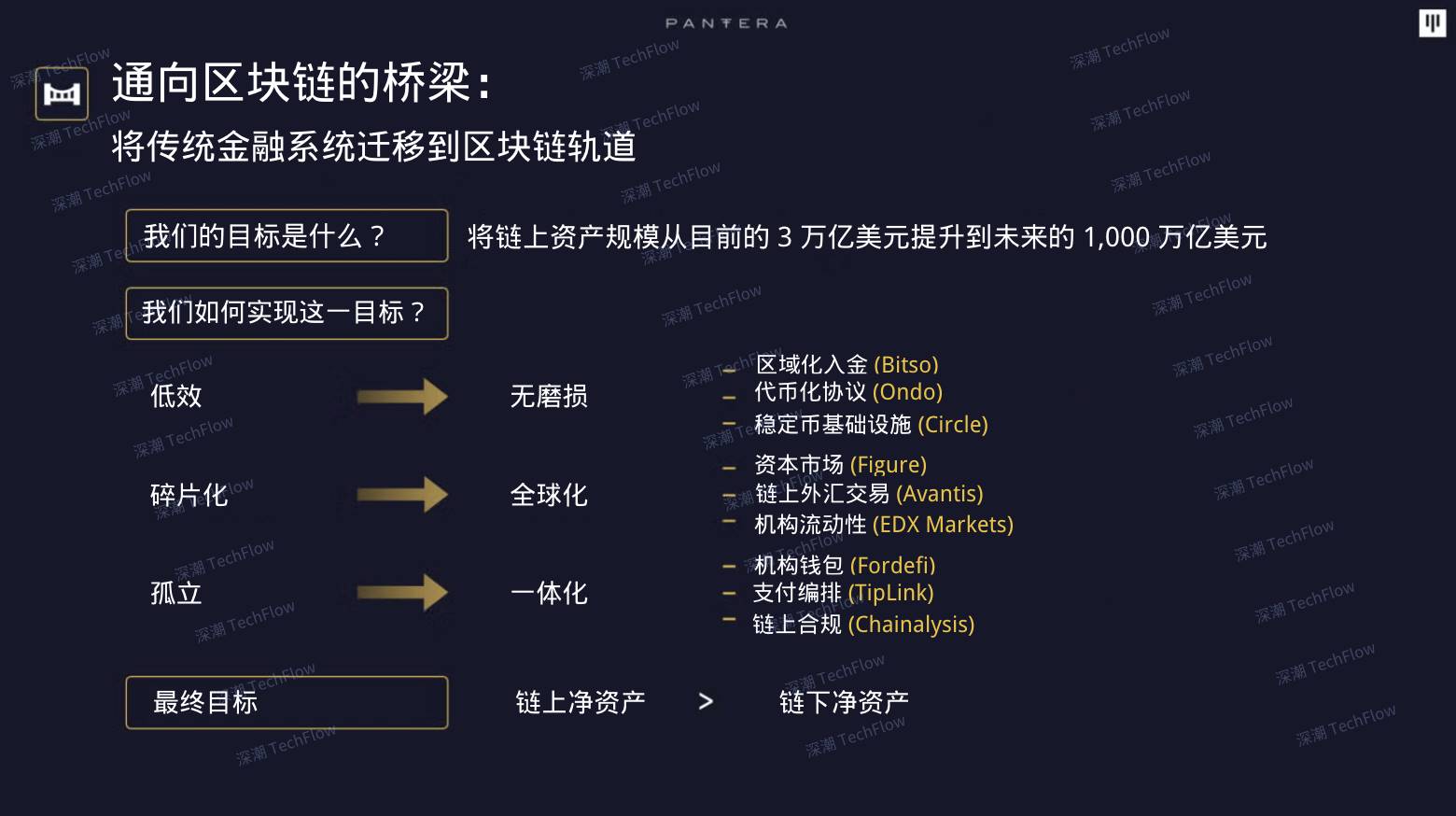
The original image is from Franklin Bi, TechFlow by TechFlow
Developers: The core driving force of the blockchain ecosystem
Currently, there are about 100,000 developers active in the blockchain field worldwide, which is only half the number of developers in a large Silicon Valley technology company. To promote mainstream adoption of blockchain, we need to increase this number to 10 million, a 100-fold increase.
Whether the potential of blockchain technology can be fully unleashed depends on whether there are better development tools. Just as the advancement of mobile development tools has unleashed the potential of the Apple App Store, we need tools that simplify blockchain application development and help developers create more practical products.
By 2025, blockchain development technology will see a major breakthrough. A key point is to make the blockchain itself more suitable for developers. Take Arbitrum's Optimistic Rollup technology as an example. This expansion solution has brought a "broadband era"-like change to the crypto industry. The upcoming Arbitrum Stylus may have a more far-reaching impact because it allows developers to write smart contracts in mainstream programming languages such as C, C++ and Rust, thereby attracting more than 10 million developers worldwide to enter the blockchain field.
Zero-knowledge technology was once considered too complex to be practical. But with the introduction of new tools such as StarkWare ’s development toolkit, the implementation of zero-knowledge technology has become simpler. Today, zero-knowledge proofs (zk-proofs) have been used in blockchain voting tools such as Freedom Tool and Rarimo , which have been deployed in Russia, Georgia, and Iran to improve democratic participation.
Tools and infrastructure that support blockchain development play an important role in driving technological progress. For example, the Alchemy platform helps developers build and deploy on-chain applications at scale by simplifying the development process. From decentralized finance (DeFi) protocols to on-chain games, Alchemy has helped multiple projects succeed. As the blockchain ecosystem continues to grow, these development platforms need to continue to iterate to help developers break through the boundaries of on-chain applications.
Looking ahead to 2025, the multichain ecosystem will further accelerate its development. Faced with increasingly complex development needs, different blockchains are emerging, each showing unique advantages in computing power, execution efficiency or degree of decentralization. Application-specific infrastructure for specific fields (such as games or transactions) is also gradually taking shape, such as B3. With the rapid growth of chains, Layer 2 and application chains, cross-chain liquidity solutions (such as Everclear ) and interoperability protocols (such as Omni ) will become key, clearing technical barriers for developers so that they can focus on building innovative applications.
Just as Web development has evolved from handwritten code to no-code tools, blockchain development is also undergoing a similar transformation. In the future, as technology advances and development tools improve, building on-chain applications may be as simple as talking to ChatGPT. This technological evolution will attract more talents to join and push the blockchain ecosystem into a new stage.
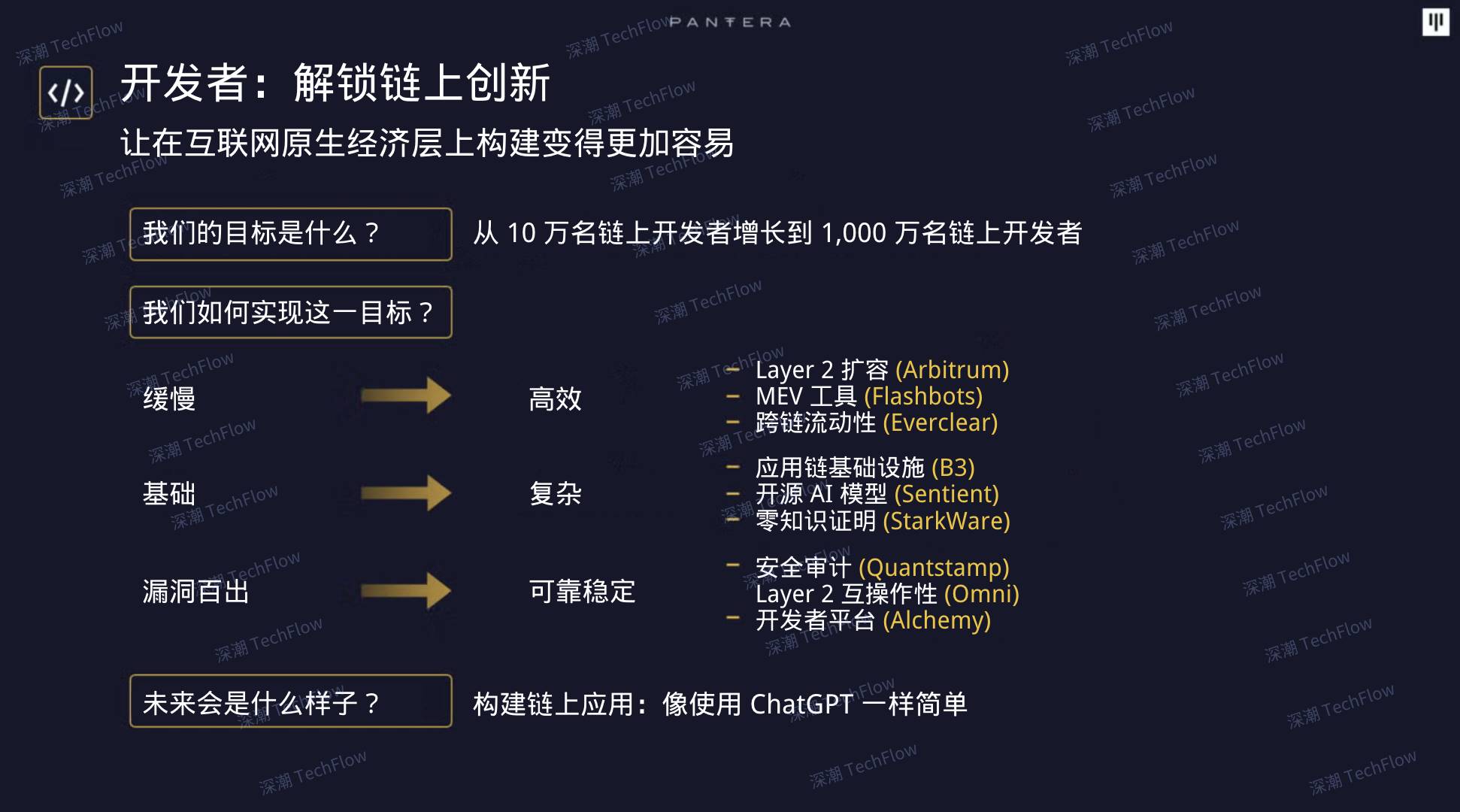
The original image is from Franklin Bi, TechFlow by TechFlow
Application: Transformation from "Wall Street" to "Main Street"
How many people have entered the onchain world at present?
According to most estimates, there are currently about 80 million on-chain users worldwide. This growth is mainly due to the appeal of cryptocurrencies as "Wall Street 2.0" - a new place to raise capital, speculate and transfer money. However, to expand this number to 8 billion people, that is, everyone in the world can participate, this requires cryptocurrencies to gradually move from "Wall Street" to "Main Street" and integrate into people's daily lives.
2025 could be a pivotal year for mainstream cryptocurrency adoption. This will be the “FarmVille moment” for blockchain technology. FarmVille was the first hit social game on Facebook, which drove exponential growth in Facebook users and transformed it from a simple photo-sharing platform into a global social network.
Today, cryptocurrencies are accelerating towards their own "FarmVille moment". More and more on-chain functions are being integrated into new games and social applications. For example, the game studio InfiniGods is attracting a large number of users who are first exposed to the chain. Their mobile casual game "King of Destiny" has been downloaded more than 2 million times in the past year, bringing users who usually prefer to play "Candy Crush" into the world of the chain instead of the traditional crypto trading platform Coinbase.
Currently, on-chain games, social networking and collectibles activities account for about 50% of the current active independent wallets. As more and more users participate in on-chain business activities, it is foreseeable that the impact of blockchain will go far beyond the financial field and penetrate into a wider range of daily life.
A new class of “productive” applications is leading a new industrial revolution. The era dominated by traditional companies is gradually giving way to the rise of “industrial networks”. These industrial networks, also known as DePINs (Decentralized Physical Infrastructure Networks), focus on solving underserved needs in areas such as wireless connectivity, hyperlocal data, and human capital. They achieve this through on-chain coordination mechanisms and market-driven approaches. For example, Hivemapper is a decentralized mapping network that has mapped more than 30% of the world’s roads, relying on data provided by more than 150,000 contributors, and its real-time and accuracy even exceeds Google Maps.
More importantly, these "production-oriented" applications are opening up real sources of revenue. We expect that by 2025, the annualized revenue in the DePIN field will exceed $500 million in 2024. These industrial-grade cash flows make it possible to make a profit model based on real-world utility, injecting strong momentum into the on-chain economy to attract more capital.
So, how can these applications reach 8 billion people around the world? In 2025, we will witness new distribution models that can reach hundreds of millions of consumers in a scalable manner. For example, crypto exchage like Coinbase, Kraken, and Binance are creating their own blockchains to help users enter the on-chain world more easily. Platforms such as Telegram and Sony are also introducing Web3 functions in their huge user ecosystems to further expand the on-chain user base.
At the same time, gaming companies are adding on-chain features to classic games such as MapleStory, potentially converting millions of players into on-chain users. Financial institutions such as PayPal and BlackRock are launching on-chain financial and payment solutions to make it easier for mainstream users to access and use blockchain technology.
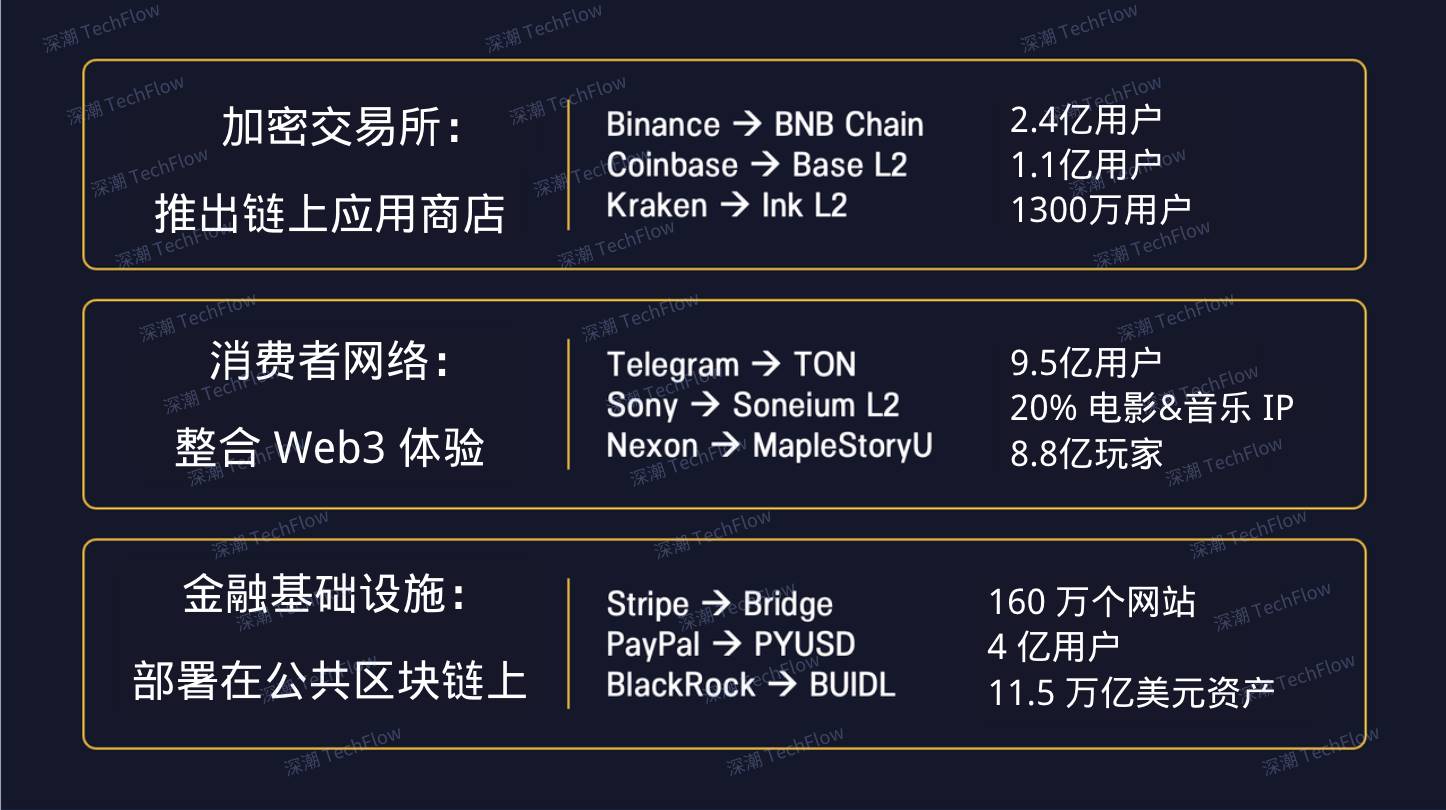
The original image is from Franklin Bi, TechFlow by TechFlow
In 2025, the intersection of various trends will lead the on-chain economy to a critical turning point. When the average person has a reason to spend 60 minutes on-chain every week, "onchain" will become as much a part of daily life as "online". Instead of pursuing a single "killer app", imagine a diverse ecosystem: just like we switch between different apps on the Internet today, people will spend time on-chain for a variety of reasons, such as entertainment, socializing, or making money. When all this happens, the on-chain economy will truly be integrated into our daily lives.

The original image is from Franklin Bi, TechFlow by TechFlow
Looking ahead: Blockchain’s accelerated path to mainstream adoption
The coming year will be the beginning of blockchain technology 's deep integration into everyday life, just as the Internet once became popular. The transformation from "Wall Street" to "Main Street" is not only happening, but is also accelerating rapidly. This process is driven by continuous innovation in entertainment, business, and practical applications.
To drive this transformation, we need to invest in making blockchain more accessible to more people, more efficient technology and development tools, and applications that solve real-world problems. 2025 is still full of great potential, and mainstream adoption of cryptocurrencies is gradually becoming a reality. As a famous saying goes: "The best way to predict the future is to invent it."
Cryptocurrency predictions for 2025
By Paul Veradittakit, Managing Partner
This year, I invited investors from the Pantera team to weigh in with me on my predictions, which I grouped into two categories: rising trends and emerging ideas.
Uptrend:
On-chain real world assets (RWAs) (excluding stablecoins) will account for 30% of the total value locked (TVL) (currently 15%)
In 2024, the total volume of on-chain real-world assets (RWAs) grew by more than 60% to $13.7 billion. Of these, about 70% of RWAs are private credit, with most of the rest being T-bills and commodities. Inflows into these categories are accelerating, and more sophisticated RWAs products may emerge in 2025.
First, the rapid growth of private credit benefits from the continuous improvement of blockchain infrastructure. For example, the Figure platform occupies almost the entire share of this market, and its on-chain assets increased by nearly $4 billion in 2024. As more and more companies enter this field, private credit is becoming a convenient way for funds to enter the crypto ecosystem.
Second, there are still trillions of dollars of treasuries and commodities off-chain waiting to be brought on-chain. Currently, there are only $2.7 billion in treasuries on-chain. Unlike stablecoins, treasuries can generate returns directly (while the returns of stablecoins are usually obtained by the issuer), making treasuries a more attractive option. For example, BlackRock's BUIDL Treasury Fund has only $500 million on-chain, while its off-chain government bonds hold tens of billions of dollars . Today, decentralized financial (DeFi) infrastructure has fully supported stablecoins and treasury RWAs (such as integrating them into DeFi liquidity pools, lending markets, and perpetual contracts), which has greatly reduced the threshold for their adoption. A similar trend is also seen in the commodity sector.
Currently, the scope of application of on-chain real-world assets (RWAs) is still limited to some basic products. However, as the infrastructure used to mint and maintain the RWA protocol continues to be simplified, operators have a deeper understanding of the risks involved in on-chain operations and their countermeasures. Today, there are professional companies responsible for managing wallets, minting mechanisms, Sybil attack detection, and crypto-new banks. These advances make it possible and feasible to introduce more complex financial products (such as stocks, ETFs, bonds, etc.). It is foreseeable that these trends will further accelerate the widespread use of RWAs in 2025 and promote the in-depth application of blockchain technology in the financial field.
Bitcoin-Fi: The Rise of Bitcoin Finance
Last year, my predictions for Bitcoin-Fi, while optimistic, did not reach 1-2% of the total volume locked (TVL) of all Bitcoin. However, this year, there are multiple factors that may drive the rapid development of Bitcoin-Fi, including Bitcoin-native financial protocols that do not require cross-chain bridges (such as Babylon), high-return yields, higher Bitcoin prices, and strong demand for more Bitcoin assets (such as runes, Ordinals, BRC20). It is expected that by 2025, 1% of Bitcoin will participate in the Bitcoin-Fi ecosystem, which marks a new breakthrough for Bitcoin in the financial field.
Fintech companies: becoming the mainstream entry point for cryptocurrencies
Platforms such as TON , Venmo, PayPal, and WhatsApp have become an important force in the development of cryptocurrencies due to their neutrality. They provide users with an entry point to interact with cryptocurrencies, but do not force specific applications or protocols, thus becoming a simplified entry channel for cryptocurrencies. These platforms attract different user groups: TON serves its 950 million Telegram users, Venmo and PayPal cover 500 million payment users respectively, and WhatsApp has 2.95 billion monthly active users.
For example, Felix is a service that runs on WhatsApp and allows users to transfer money instantly with a simple message. Funds can be transferred digitally or picked up in cash at partner locations such as 7-Eleven. On a technical level, Felix uses Bitso, a stablecoin and Stellar network. Meanwhile, users can now buy cryptocurrencies on MetaMask through Venmo ; Stripe acquired stablecoin company Bridge , and Robinhood acquired crypto exchage Bitstamp .
Whether by design or due to their ability to support third-party applications, these fintech companies are becoming mainstream on-ramps into cryptocurrencies. As they gain popularity, fintechs are likely to compete with smaller centralized exchanges in terms of cryptocurrency holdings.
4. Unichain: The second layer network with the largest transaction volume
Uniswap 's current total locked value ( TVL ) is about $6.5 billion, and it processes 50,000 to 80,000 transactions per day, with a daily trading volume of between $1 billion and $4 billion. Arbitrum's daily trading volume is about $1.4 billion (one-third of which comes from Uniswap), and Base's daily trading volume is about $1.5 billion (one-quarter of which comes from Uniswap).
If Unichain can capture half of Uniswap's transaction volume, it will easily surpass the current largest second-layer (L2) network and become the L2 with the highest transaction volume. This not only shows the potential of Unichain, but also marks the further maturity of the decentralized finance (DeFi) ecosystem.
5. The revival of NFT : from tools to diversified applications
NFT (Non-Fungible Token) was originally designed as a tool in blockchain technology, not an end in itself. Today, the scope of NFT applications continues to expand, covering multiple fields such as on-chain games, artificial intelligence (ownership for trading models), identity authentication, and consumer applications.
For example, Blackbird is a restaurant rewards application that integrates NFT into the customer identity system, seamlessly combining Web3 technology with the catering industry. By leveraging the openness, liquidity, and identifiability of blockchain, Blackbird is able to provide restaurants with consumer behavior data while easily creating features such as subscriptions, memberships, and discounts.
Sofamon has developed Web3 versions of emojis that exist in the form of NFTs, called "wearables." This innovation unlocks the financial potential of the emoji market. They also recognize the importance of on-chain intellectual property (IP) and work with top KOLs and K-pop stars to combat digital counterfeiting. For example, Story Protocol recently raised $80 million at a valuation of $2.25 billion. Its goal is to tokenize global intellectual property and put originality back at the core of creative exploration. Swiss luxury watch brand IWC has also launched a membership-based NFT , which allows holders to join exclusive communities and participate in exclusive events.
The flexibility of NFT enables it to be used in scenarios such as identity authentication, transaction records, asset ownership, and membership management, while also representing and evaluating the value of assets. This flexibility not only brings monetization opportunities, but may also drive speculative growth in the market. As the technology matures, the application scenarios of NFT will continue to expand.
6. Restaking Protocol: A Key Step Towards Mainnet
In 2025, resttaking protocols such as EigenLayer , Symbiotic , and Karak will be officially launched on the mainnet. These protocols provide operators with benefits through validator services (AVS) and penalty mechanisms. Although the popularity of resttaking has weakened in the past year, its potential cannot be ignored.
The impact of Restaking grows as more networks adopt it. If certain protocols' infrastructure is driven by a specific Restaking protocol, they can benefit from it even if the connection is not direct. This feature allows certain protocols to maintain high valuations even if they lose some relevance. We expect Restaking to remain a multi-billion dollar market, and as more applications transform into Appchains, they will gradually adopt the Restaking protocol, or other protocols built on top of it.
Emerging concepts:
7. zkTLS: A new technology that brings off-chain data to the chain
zkTLS (Zero-Knowledge Transport Layer Security) is a new technology based on zero-knowledge proofs to verify the authenticity of data from the Web2 world. Although this technology has not yet been fully implemented, once it is implemented this year, it will introduce a new type of data to the blockchain ecosystem.
For example, zkTLS can be used to prove that certain data indeed came from a specific website, which is currently not possible with existing technologies. This technology combines the latest advances in trusted execution environments (TEEs) and multi-party computations (MPCs), and may be further developed to support privacy protection of some data.
While zkTLS is still in the conceptual stage, we expect that companies will invest resources to develop this technology and integrate it into on-chain services. For example, it can be used as a verifiable oracle for non-financial data, or as a cryptographically secure data oracle to provide broader data support for the blockchain ecosystem.
8. Regulatory support: The shift in US cryptocurrency policy
For the first time, the regulatory environment in the United States has shown a positive attitude towards cryptocurrencies. In the new election, 278 House of Representatives candidates who support cryptocurrencies were elected, while only 122 candidates who oppose cryptocurrencies were elected. In addition, the current Chairman of the Securities and Exchange Commission (SEC), Gary Gensler, who has long been opposed to cryptocurrencies, announced that he will resign in January next year. According to reports, Trump plans to nominate Paul Atkins as the new Chairman of the SEC. Paul Atkins served as an SEC Commissioner from 2002 to 2008. He not only publicly supports the cryptocurrency industry, but also serves as an advisor to the Chamber of Digital Commerce, which is committed to promoting the popularity and acceptance of cryptocurrencies.
At the same time, Trump also appointed technology investor, former Yammer CEO and PayPal COO David Sacks to the newly created position of "AI & Crypto Czar". In the statement, Trump specifically mentioned: "[David Sacks] will be responsible for developing a legal framework to provide the cryptocurrency industry with the clarity it has long desired."
This series of changes makes people look forward to the future of the cryptocurrency regulatory environment in the U.S. We hope to see a gradual reduction in SEC lawsuits, a clear definition of cryptocurrency as a specific asset class, and clearer tax policies.
Cryptocurrency: An unexpected boost to de-dollarization
By Jeff Lewis (Hedge Fund Product Manager) and Erik Lowe (Content Director)
In recent years, the global trend of "de-dollarization" has become increasingly obvious. Countries and institutions have gradually reduced their reliance on the US dollar in international trade and financial transactions, which has raised concerns about the long-term dominance of the US dollar.
A common measure of the dollar’s dominance is the dollar’s share of global foreign exchange reserves. However, this share has continued to decline since 2000, having fallen by 13 percentage points.

However, we believe this trend is about to reverse, and the forces driving this change are precisely blockchain technology and tokenization - technologies that were once thought to have the potential to weaken the dollar. Ironically, they are now becoming the dollar's most powerful boosters.
As Elon Musk said, “The most ironic outcomes are often the most likely.”
Augmented Dollar: How Blockchain Can Help U.S. Dollar Dominance
Public blockchains have breathed new life into fiat currencies, enabling them to reach 5 billion smartphone users worldwide and facilitate cross-border payments. The surge in demand for tokenized fiat currencies, or stablecoins, has spawned a $200 billion market, dominated by the U.S. dollar.
A report released by Castle Island and Brevan Howard shows that the proportion of assets collateralized by the US dollar in the stablecoin market is almost 100%. This phenomenon shows that blockchain technology has not only failed to weaken the status of the US dollar, but is further consolidating the dominant position of the US dollar in the global financial system through its efficiency and global characteristics.
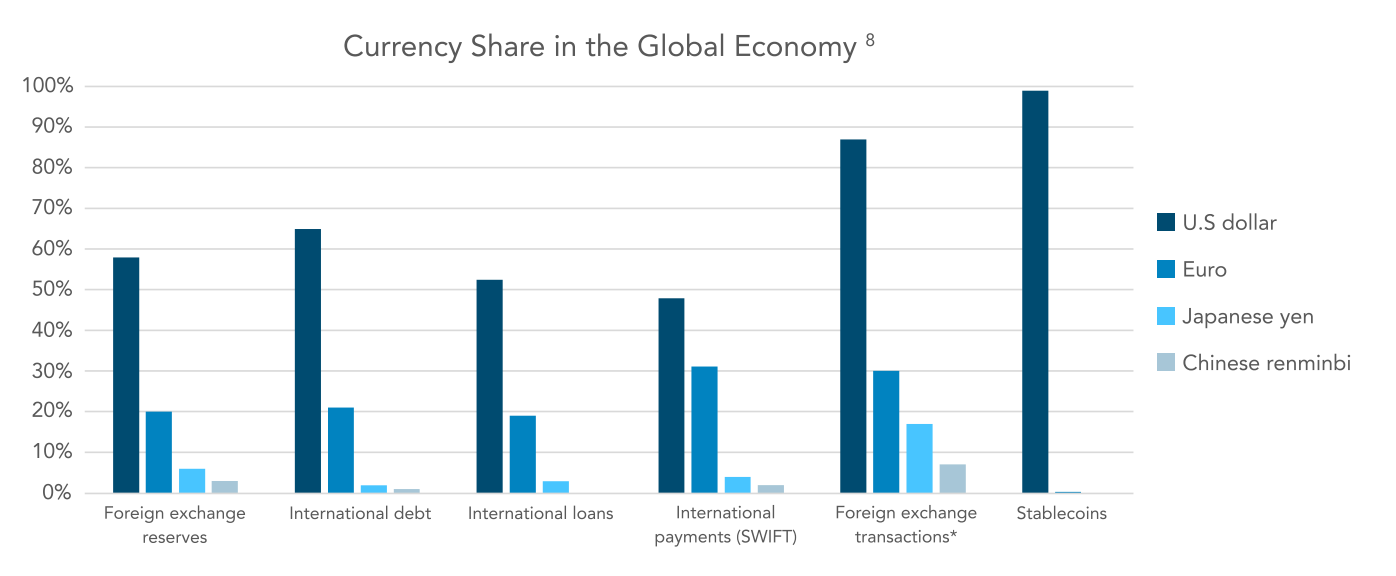
Data source: Castle Island and Brevan Howard Report
Of the top 20 fiat-backed stablecoins, 16 have “USD” in their names.
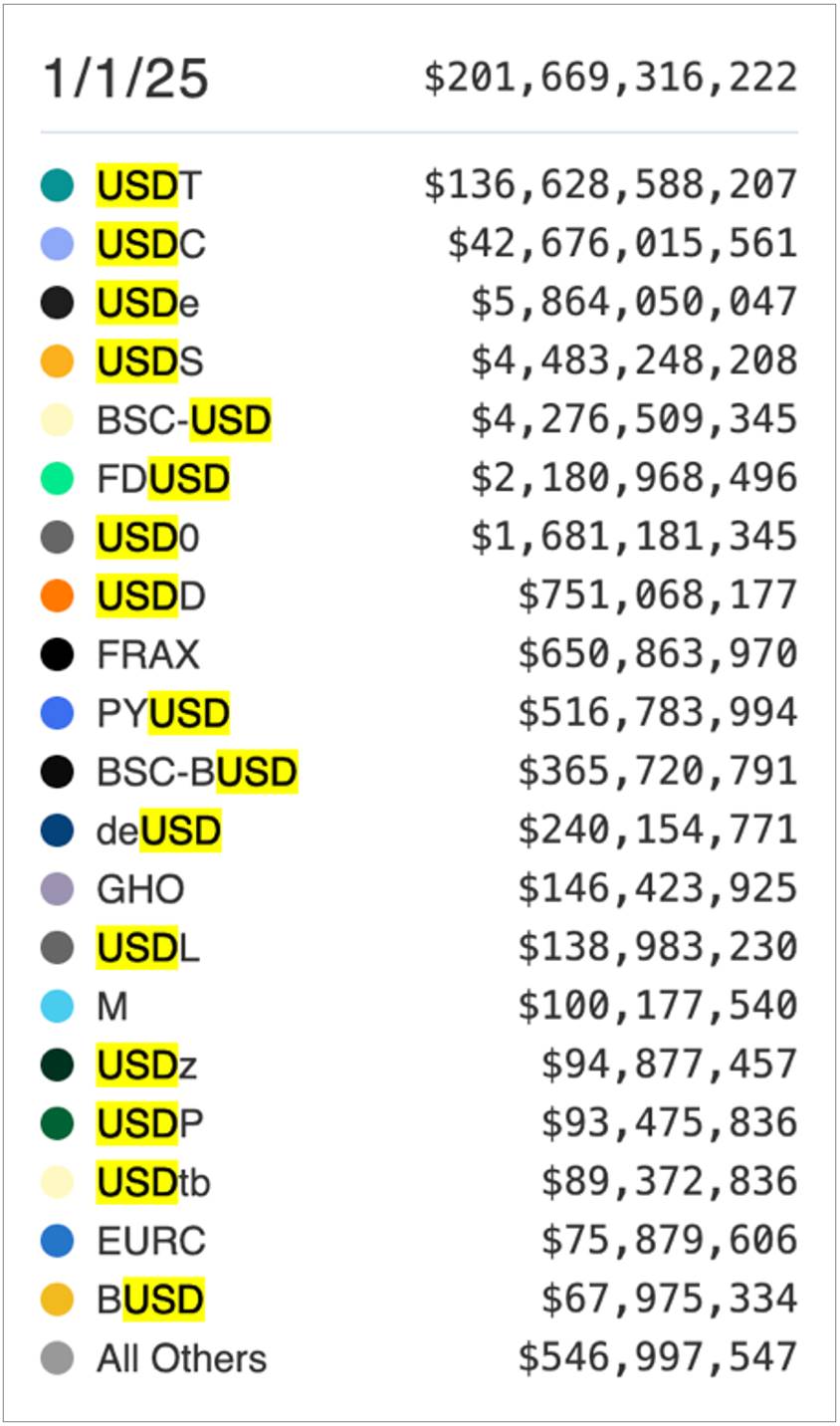
Data source: rwa.xyz
Despite the continued development of blockchain technology over the past 16 years, the public's overall perception of it has changed little. Early supporters of Bitcoin had high hopes that it could challenge the global dominance of the U.S. dollar. However, over time, Bitcoin has come to be seen as a "digital gold," a tool for storing wealth rather than an actual medium of exchange. At this point, Bitcoin's threat to the U.S. dollar has significantly diminished.
At the same time, the rapid rise of stablecoins and RWAs (real world assets) is delivering on Bitcoin’s original promise, providing a more stable medium of exchange with real returns for blockchain. This development has not diminished the importance of the US dollar, but has further amplified its global influence through blockchain technology.
The rise of stablecoins in emerging markets
In emerging markets, dollar-backed stablecoins have become a practical financial tool, providing an alternative to people holding cash or relying on fragile banking systems. In countries with depreciating currencies or unstable economies, merchants and residents often prefer the stability of digital dollars.
The report by Castle Island and Brevan Howard surveyed existing cryptocurrency users in countries such as Nigeria, Indonesia, Turkey, Brazil, and India, revealing the important role of stablecoins in these markets:
Savings needs : 47% of respondents said that their main purpose for using stablecoins is to save money in U.S. dollars. This proportion is only slightly lower than the 50% who use stablecoins for cryptocurrency or NFT transactions.
Currency Conversion : 69% of respondents have converted local currency into stablecoins, regardless of trading activity, indicating broad demand for stablecoins beyond payments and savings.
Future expectations : 72% of respondents expect the use of stablecoins to increase in the future, reflecting the potential of this tool in emerging markets.
Whether it is ordinary consumers with small savings or multinational companies, when economic entities tend to choose the safest and most liquid financial instruments, stablecoins backed by the US dollar are gradually squeezing out the use of local currencies. This phenomenon shows that stablecoins not only provide practical application scenarios for blockchain technology, but also further consolidate the position of the US dollar in the global economy.
Stablecoin Legislation in 2025: A Smart Move in America’s Interest
As the legislative process progresses, it is widely expected that the Trump administration will push for stablecoin-centric regulations. Patrick McHenry's Stablecoin Act, which has bipartisan support and was originally proposed in 2023 and recently submitted to the House of Representatives by Representative Maxine Waters, has long been seen as an important first step in promoting clarity in US cryptocurrency regulation. We believe that by 2025, substantial progress will be made in related areas, especially as policymakers gradually realize the strategic significance of stablecoins in expanding the global influence of the US dollar.
Widespread adoption of stablecoins is in the U.S. national interest. Not only can they increase the proportion of global transactions denominated in U.S. dollars, they can also create demand for U.S. Treasuries as collateral. For a country with $37 trillion in outstanding debt, stablecoins and cryptocurrencies offer an innovative distribution channel.
Stablecoins and CBDCs: Essential Technical Differences
It should be clear that fiat-backed stablecoins and central bank digital currencies (CBDCs) are two similar but fundamentally different technologies and should not be confused.
JP Morgan mentioned new technologies that promote payment autonomy as one of the potential drivers of de-dollarization in a report published in October 2025. They cited projects like mBridge , a digital currency initiative jointly developed by multiple central banks, as possible alternatives to US dollar transactions.
While the rise of foreign CBDCs and other payment systems does increase pressure to de-dollarize, we believe that the rapid development of stablecoins backed by the U.S. dollar has effectively offset this trend. In our view, stablecoins built on decentralized and permissionless blockchain technology will become a more popular choice due to their stronger privacy protection capabilities, censorship resistance, and multi-platform interoperability.
Stablecoins and Tokenized Treasuries: New Drivers of Demand for U.S. Treasuries
According to the U.S. Treasury Department, approximately $120 billion of stablecoin collateral is currently invested directly in U.S. Treasuries, which has significantly increased the market demand for short-term Treasury bonds. In addition to stablecoins, direct tokenization of U.S. Treasury bonds has also become an emerging trend. Digitizing Treasury bonds through blockchain technology not only improves their liquidity, but also provides investors with a more convenient way to trade.
Currently, companies such as BlackRock (through Securitize), Franklin Templeton, Hashnote and Pantera-backed Ondo are leading the way in this market, which is estimated to be worth $4 billion. This trend shows that blockchain technology has great potential not only in the payment field, but also in the digitization of traditional financial assets.
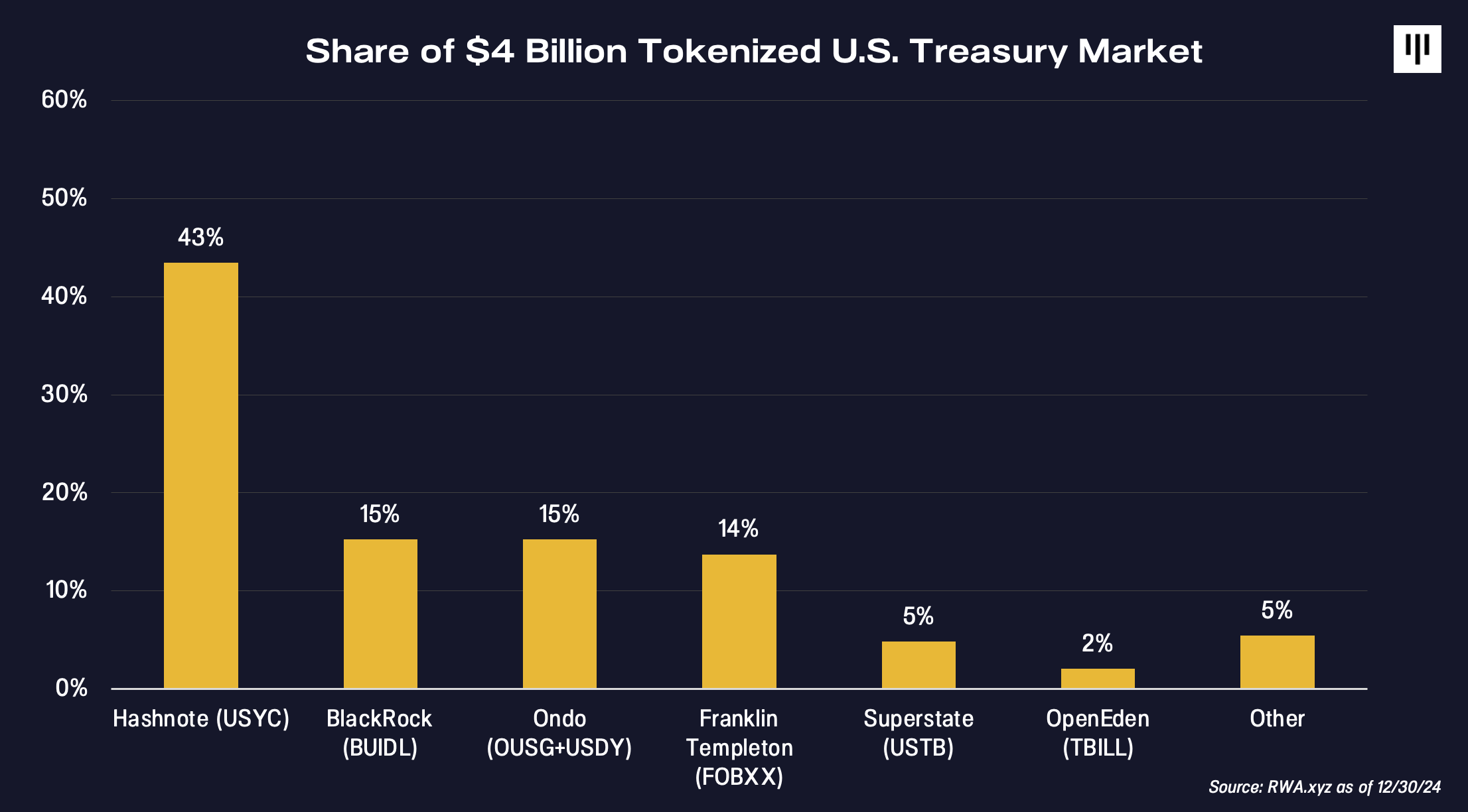
Ondo has launched two core products in the field of on-chain assets, aiming to provide investors with more convenient and efficient investment channels:
USDY (Dollar Yield Token): USDY is a tokenized note backed by short-term U.S. Treasury bonds and bank deposits. Designed for non-U.S. investors, it provides a stable, high-quality yield while simplifying the process of acquiring U.S. dollar assets.
OUSG (Ondo Short-Term U.S. Government Bonds): OUSG provides liquid exposure to short-term U.S. Treasury bonds, allowing qualified investors to mint and redeem them instantly. This flexibility allows investors to manage asset allocation more efficiently.
Compared with traditional channels, products such as USDY provide overseas investors with a simpler and more convenient way to obtain US dollar and U.S. Treasury assets.
The New Era of Dollar Dominance: The Power of Blockchain
Blockchain technology has not only failed to weaken the global dominance of the US dollar, but has further consolidated its core position through digital infrastructure. Even in the face of de-dollarization pressure brought about by geopolitical and technological changes, the tokenization and liquidity of US dollar assets around the world make it irreplaceable.
JPMorgan Chase pointed out in the report that the dollar's dominance is due to three powerful structural factors:
Deep capital market
Legal protection
Institutional transparency
These advantages are unmatched in the current global financial system, and the emergence of stablecoins extends these characteristics to a digital and borderless context.
In fact, the U.S. dollar has become the biggest beneficiary of blockchain technology. The “killer app” of blockchain may be the dollar itself, which also shows that technology can not only transform traditional power structures, but also further strengthen them. As the regulatory framework gradually improves and the demand for tokenized assets surges, the on-chain migration of the U.S. dollar will further consolidate its position as the cornerstone of global finance. Whether the U.S. regulators are Democrats or Republicans, they will support any force that can increase the demand for U.S. Treasuries, making relevant regulatory progress almost inevitable.
Three major trends in DeFi: On-chain integration of real-world assets
By: Mason Nystrom, Junior Partner
With the improvement of user experience and the increasing maturity of the protocol, DeFi is developing rapidly, attracting more and more users and capital. In my blog post, I explored three key trends shaping DeFi. Here is a brief overview of one of the trends:
RWA Flywheel Effect: From Endogenous Growth to Exogenous Growth
Since 2022, the high interest rate environment has driven the on-chain migration of a large number of real-world assets (RWA). Asset management giants like BlackRock have realized that putting RWA on the chain can bring the following significant advantages:
Programmable financial assets : automated operations through smart contracts.
Lower cost structure : Reduce the cost of asset issuance and maintenance.
Greater accessibility : enabling more investors to gain access to high-quality assets.
These advantages are similar to those of stablecoins , and bring a 10-fold efficiency improvement compared to the traditional financial system.
According to data from RWA.xyz and DefiLlama, RWA currently accounts for 21%-22% of Ethereum's on-chain assets. These assets mainly exist in the form of Class A U.S. Treasury bonds, and their growth has benefited from the high interest rate environment. However, even if the macroeconomic environment changes in the future, the trend of on-chain asset tokenization has penetrated Wall Street, paving the way for more RWA to be on-chain.
As traditional assets gradually migrate to the chain, this will trigger a flywheel effect of compound growth, accelerating the integration and replacement of traditional financial tracks with DeFi protocols.
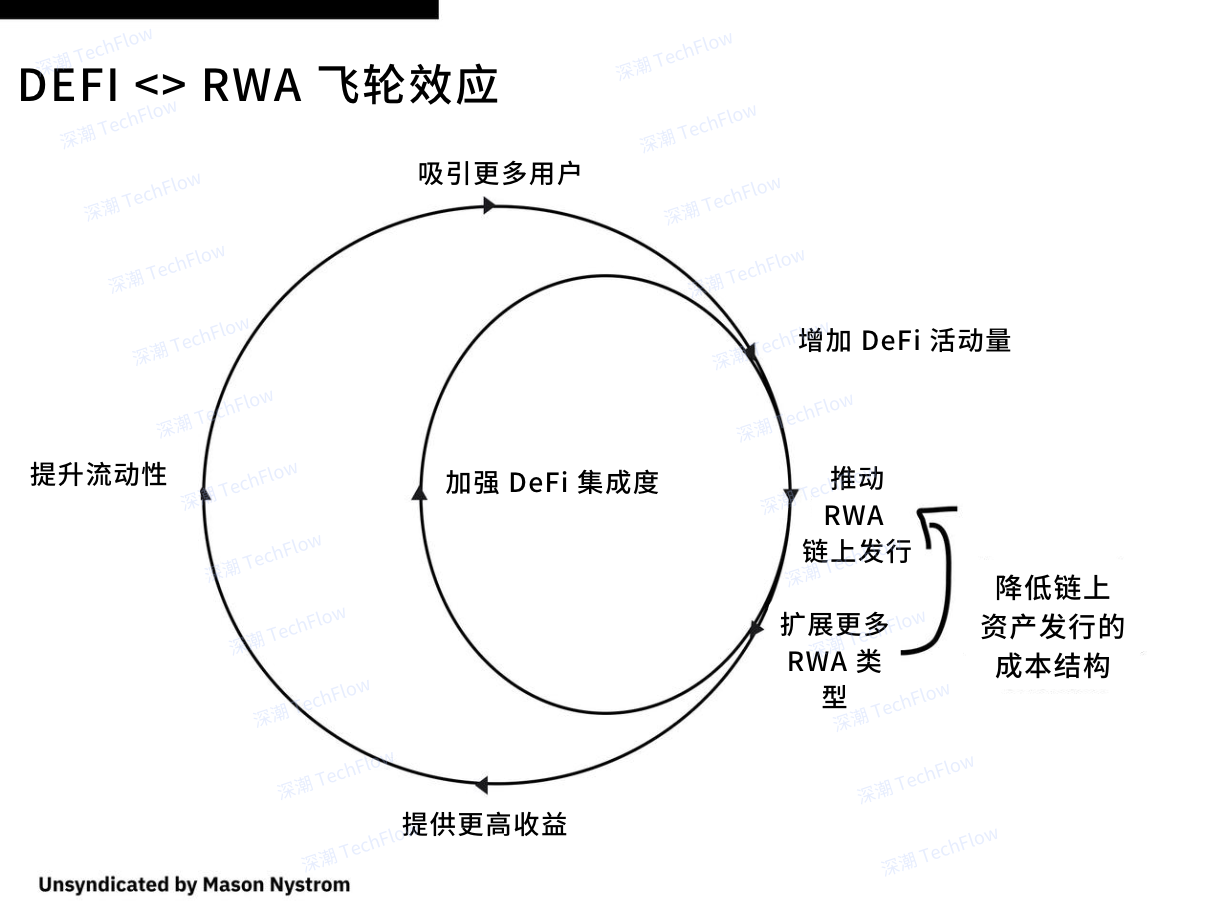
Original image from TechFlow Nystrom, compiled by TechFlow
Why is this important? The growth of the cryptocurrency market can be attributed to two important sources: endogenous capital and exogenous capital.
Currently, most decentralized finance (DeFi) funding is endogenous, meaning that it circulates primarily within the DeFi ecosystem and is able to grow itself through on-chain activity. Despite this, the DeFi landscape tends to be highly cyclical: markets rise, pull back, and then cycle again. But over time, new financial instruments (or “financial primitives”) have emerged, gradually expanding the overall market size of DeFi.
For example, on-chain lending protocols such as Maker, Compound, and Aave have expanded the application scenarios of DeFi by allowing users to obtain leverage by using crypto assets as collateral. The emergence of decentralized exchanges (especially automated market makers AMMs) has not only increased the types of tradable tokens, but also greatly improved on-chain liquidity. However, DeFi's endogenous growth capacity is limited. Although speculation in on-chain assets (i.e., endogenous capital) has developed cryptocurrencies into a mature asset class, exogenous capital must be introduced to drive the next wave of growth in DeFi - that is, traditional financial capital outside the chain.
Real-world assets (RWA) offer a huge opportunity for this. RWAs include traditional assets such as commodities, stocks, private credit, and foreign exchange, which represent a large amount of potential exogenous capital that can help DeFi break through the limitations of the internal circulation of funds. For example, just as the stablecoin market needs to grow through off-chain practical uses (such as cross-border payments or savings tools), other activities in DeFi (such as trading, lending) also need similar exogenous capital injections.
Looking ahead, the direction of DeFi development is to migrate all financial activities to the blockchain. We expect that the expansion of DeFi will proceed in parallel along two paths: one is endogenous expansion through the increase of native activities on the chain, and the other is exogenous expansion through the on-chain of real-world assets.
“BUY THE RUMOR, BUY THE NEWS”: The Success Story of Bitcoin ETF
A year ago, we published an article in our November Blockchain Letter titled “The Upcoming Bitcoin ETF: BUY THE RUMOR, BUY THE NEWS.”
We put forward a point of view: although "BUY THE RUMOR, SELL THE NEWS" is the classic operating logic of Wall Street, this rule may not apply to the launch of spot Bitcoin ETF . In fact, this prediction has been verified.
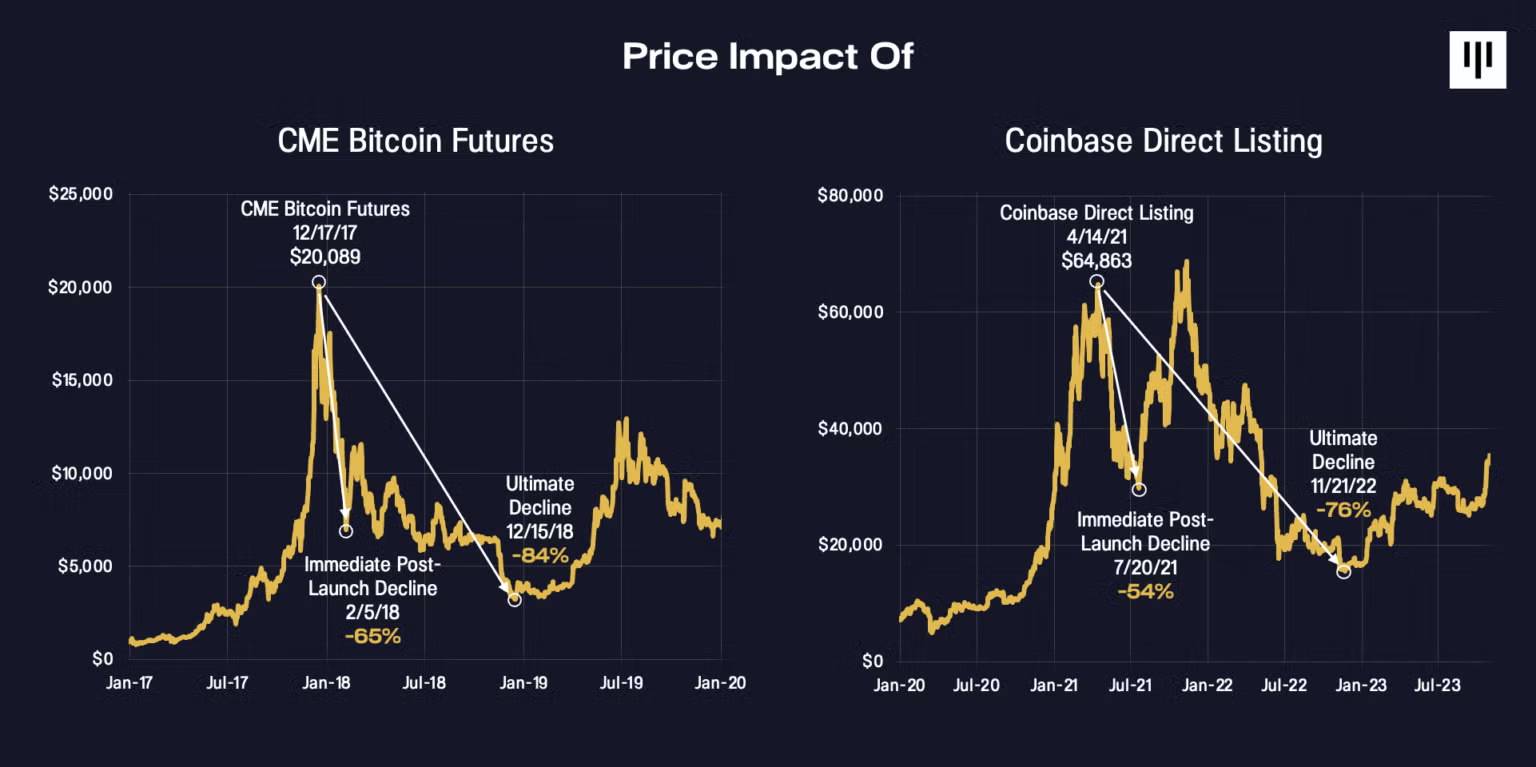
Since the launch of the Bitcoin ETF, the price of Bitcoin has risen 103%.
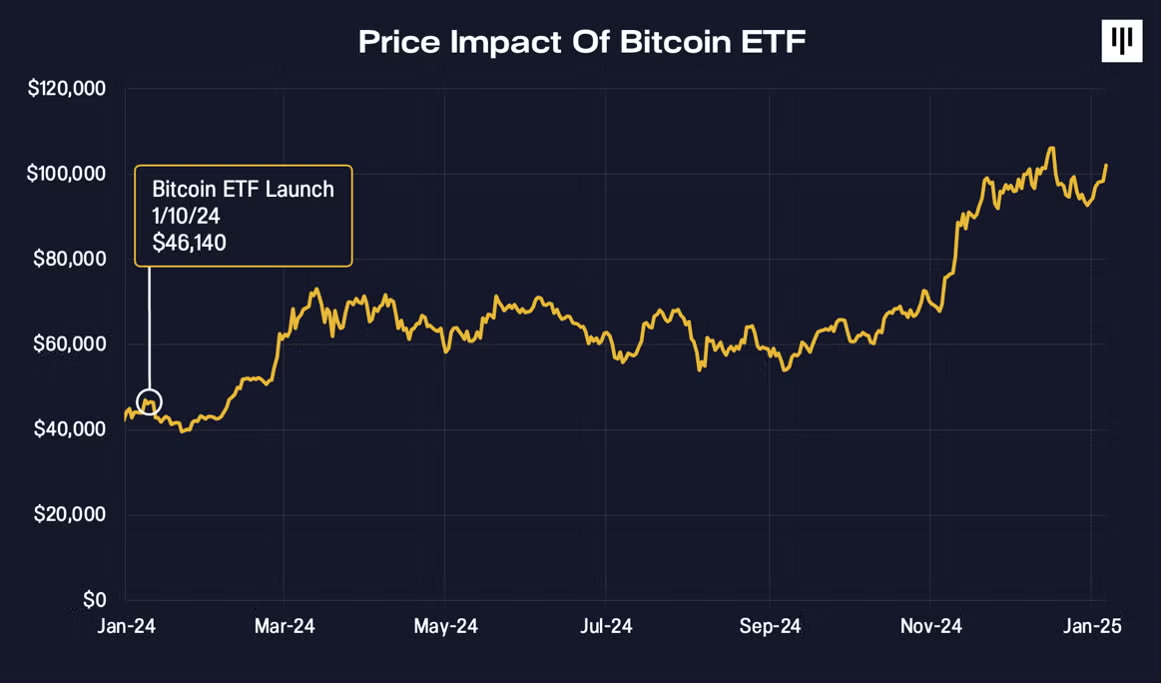
Just 11 months after its launch, BlackRock’s Bitcoin ETF surpassed the total assets of its gold ETF launched 20 years ago. This achievement is considered the “most successful launch in ETF history”, and its asset size exceeded $50 billion five times faster than the second fastest ETF.
Next month, I will delve deeper into why the impact of the US election has not yet been fully understood by the market and reflected in the price of Bitcoin. I believe that the US election will be another classic case of "buy the rumor, buy the news."




